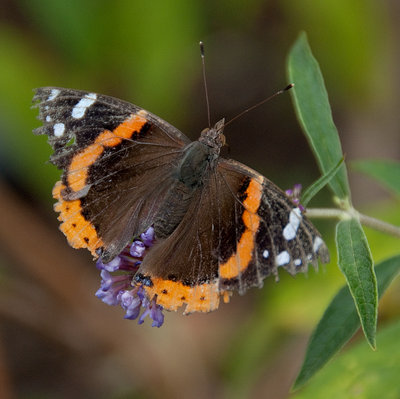It was a royal affair as red admirals and viceroys alighted upon Queen Anne’s Lace while the mysterious monarch would elude some for the second annual Butterfly Day held on July 24 at the nearby Dekorte Park in Lyndhurst.
The New Jersey Meadowlands Commission, which oversees zoning in most of Secaucus and also runs public events, said that the day drew 350 people including an estimated 175 children from North Jersey.
“So great to see so many families out here,” said Jim Wright, communications officer, at the event. “Turn out is beyond our expectation. People have been so enthusiastic.”
“I happen to love butterflies.” – Debbie Lewis
____________
Outside visitors enjoyed guided walking tours, bird-watching and exploring the foot bridges while inside visitors watched an informative slideshow on Meadowlands wildlife and cooled off from the heat.
Budding urban eco-system attracts butterflies
Twelve thousand years ago, a retreating glacier left behind the Hackensack River and the surrounding marshes. In the recent past, they suffered from pollution and environmental degradation. But today the area is home to a budding urban ecosystem.
Some people came face to face with nature at the sight of a robber fly sucking the juices out of a green bottle fly.
“It’s a passion,” said Fred Pfeiffer, 58, from Woodland Park, about his interest in looking at butterflies, a hobby he has pursued for seventeen years. He stopped to photograph a baby robin and was equipped with a high tech camera, like many other enthusiasts who had macro lenses to zoom in.
Although butterflies typically flutter about in July heat, they were not out in large numbers during last week’s hot spell. But nature-lovers enjoyed searching for them amongst the butterfly bush, coneflowers, coreopsis, Queen Anne’s Lace, wild bergamot, milkweed, and other flowers found in the meadows.
“I happen to love butterflies.” said Debbie Lewis of Fairfield, 39, who was celebrating her 18th wedding anniversary with her husband, Mark Lewis, 36.
Nature-lovers spotted 15 species of butterfly including the red admiral, cabbage white, broadwinged skipper, viceroy, silver-spotted skipper, orange sulphur, peck’s skipper, pearl crescent, common buckeye, gray hairstreak, Eastern tiger swallowtail, question mark, American lady, monarch, and clouded sulphur.
Children had a chance to identify the different species on a butterfly guide provided by the park during a scavenger hunt.
A few lucky park visitors also caught sight of a clear-winged moth, which has transparent wings and resembles a bee, as well as two ravens and a peregrine falcon.
“Even when the butterfly numbers are down, just the act of looking for them brings you closer to nature – and that’s a good thing. There’s a whole other world out there, and it’s real,” said Wright.
The missing monarch
“Everyone should plant milkweed, even if you only have a terrace,” said Don Torino, a member of the BCAS and NABA. “Without milkweed, you have no monarch butterflies.”
Butterfly enthusiasts caught sight of only one monarch last Sunday. The popular butterfly, known for its bright orange-colored wings; is unique in that it travels up to 3,000 miles across North America.
According to Wright, the numbers of butterflies are down from the past two summers but that could be for any number of reasons. One of those reasons could be the eradication of milkweed out in the Midwest due to crops of genetically modified soybeans and corn that are resistant to the herbicide Roundup.
While farmers benefit from the reduction in milkweed, a growing number of scientists fear it is imperiling the monarch butterfly, according to the New York Times. The article refers to the findings in a paper, published online by the journal Insect Conservation and Diversity, that also attributes the loss of milkweed to land development, illegal logging at the wintering sites in Mexico, and severe weather.
Other scientists dispute that there is a decline, indicating that the population fluctuates and varies across the migration route.
While further scientific work is needed to verify the real causes behind the apparent decline, observations continue to be made by butterfly enthusiasts who have been watching the monarch for years, like Torino, who maintains a butterfly garden for the BCAS.
“We could make up for [the decline] in our own backyard,” he said after the event. “People cut down milkweed and put in exotic plants that aren’t beneficial. Milkweed is a beautiful plant, smells great, and there are different varieties. It is something we can do immediately.”
Adriana Rambay Fernández may be reached at afernandez@hudsonreporter.com.
